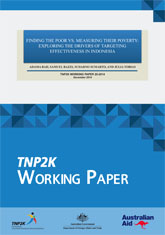Finding the Poor vs. Measuring their Poverty: Exploring the Drivers of Targeting Effectiveness in Indonesia
Working Paper 20
November 2014
Authors: Adama Bah, Samuel Bazzi, Sudarno Sumarto, and Julia Tobias
Centralised targeting registries are increasingly used to allocate social assistance benefits in developing countries. This paper provides the first attempt to identify the relative importance of two key design issues for targeting accuracy: (1) which households to survey for inclusion in the targeting registry and (2) how to rank surveyed households. We evaluate the performance of Indonesia’s Unified Database for Social Protection Programmes (UDB), the largest targeting registry in the world, which is used to provide social assistance to more than 25 million households. Linking administrative data with an independent household survey, we find that the UDB system is more progressive than previous targeting approaches used in Indonesia, leading to a decrease in benefit leakage to non-poor households. However, if poor households are not surveyed in the first place, even a perfect ranking method cannot prevent their exclusion. Under a simulation that considers enumerating and estimating proxy-means testing (PMT) scores for all households (as in a census), we estimate a one-third decrease in undercoverage compared to focusing on households that have been registered in the UDB. Investigating household- and community-level correlates of misenumeration and misclassification, we find evidence that local communities use different definitions of poverty and have better information on the welfare status of their members.
__________________________________________________________________________
The TNP2K Working Paper Series disseminates the findings of work in progress to encourage discussion and exchange of ideas on poverty, social protection, and development issues.
Support for this publication has been provided by the Australian Government through the Poverty Reduction Support Facility (PRSF).
The findings, interpretations, and conclusions herein are those of the author(s) and do not necessarily reflect the views of the Government of Indonesia or the Government of Australia.
You are free to copy, distribute, and transmit this work for non-commercial purposes.
Suggested citation: Bah, Adama, Samuel Bazzi, Sudarno Sumarto, and Julia Tobias. 2014. ‘Finding the Poor vs. Measuring Their Poverty: Exploring the Drivers of Targeting Effectiveness in Indonesia’. TNP2K Working Paper 20-2014. Jakarta, Indonesia: Tim Nasional Percepatan Penanggulangan Kemiskinan (TNP2K).
To request copies of the paper or for more information, please contact the TNP2K Knowledge Management Unit (kmu@tnp2k.go.id). This and other TNP2K publications are also available at the TNP2K website (www.tnp2k.go.id).
